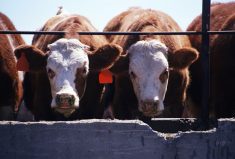Western Canadian feeder cattle prices were relatively unchanged from week-ago levels although a softer tone was noted late in the week. After two weeks of slightly higher values, buyers took on the attitude of cutting one’s coat according one’s cloth. Each cattle feeder appears to have his or her own view of the market and is placing bets accordingly. A few brave souls were noted buyers earlier in the week, but as the futures markets eroded, their nimblewitted minds pulled in the reins.
Wholesale beef values were down marginally from seven days earlier, which caused a softer tone in the fed cattle market. Alberta packers were extremely evasive buying limited volumes and the two-cent weekly gain in the Canadian dollar wasn’t helping export values.
Read Also

Bring focused approach to target systems, not producers says animal activist
Darren Vanstone explains the process of reframing animal agriculture through advocacy and activism at the Human Canada One Health One Welfare Conference.
Feed barley was readily trading at $160 per tonne, delivered Lethbridge, and feedlot operators are banking on lower costs per pound gain. Early harvest results reflect a burdensome feed grain situation this fall.
Mixed steers averaging around 925 lbs. were readily trading at $180 across Alberta while markets in Saskatchewan and Manitoba were too thin to define. Farmers are in the midst of harvest so the bulk of the yearlings will only come on the market later in September. A small group of larger-frame mixed steers averaging just over 800 lbs. sold for $192 in central Alberta while red and black heifers of similar weight traded for $177.
Featureless steer calves weighing from 650 to 700 lbs. were quoted in the range of $200-$205; 600- to 625-lb. heifers were trading from $178 to $185. Once again very few calves were on offer this week. Much of Alberta and Saskatchewan has received over 200 per cent of normal precipitation during the past 30 days. While pastures remain in optimal condition, the weather is not optimal for moving, weaning or pre-conditioning calves.
The fed and feeder cattle markets have to absorb the surge in third-quarter beef supplies. Later in fall, I’m expecting the feeder market to percolate higher on stronger consumptive demand and lower weekly beef production.
— Jerry Klassen is manager of the Canadian office for Swiss-based grain trader GAP SA Grains and Produits. He is also president and founder of Resilient Capital, which specializes in proprietary commodity futures trading and commodity market analysis. Jerry owns farmland in Manitoba and Saskatchewan but grew up on a mixed farm/feedlot operation in southern Alberta, which keeps him close to the grassroots level of grain and cattle production. Jerry is a graduate of the University of Alberta. He can be reached at 204-504-8339.
















